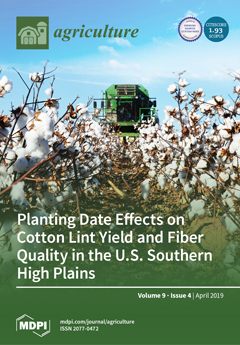Open AccessArticle
Actual Evapotranspiration and Tree Performance of Mature Micro-Irrigated Pistachio Orchards Grown on Saline-Sodic Soils in the San Joaquin Valley of California
by
Giulia Marino, Daniele Zaccaria, Richard L. Snyder, Octavio Lagos, Bruce D. Lampinen, Louise Ferguson, Stephen R. Grattan, Cayle Little, Kristen Shapiro, Mahesh Lal Maskey, Dennis L. Corwin, Elia Scudiero and Blake L. Sanden
Cited by 19 | Viewed by 6279
Abstract
In California, a significant percentage of the pistachio acreage is in the San Joaquin Valley on saline and saline-sodic soils. However, irrigation management practices in commercial pistachio production are based on water-use information developed nearly two decades ago from experiments conducted in non-saline
[...] Read more.
In California, a significant percentage of the pistachio acreage is in the San Joaquin Valley on saline and saline-sodic soils. However, irrigation management practices in commercial pistachio production are based on water-use information developed nearly two decades ago from experiments conducted in non-saline orchards sprinkler-irrigated with good quality water. No information is currently available that quantify the effect of salinity or combined salinity and sodicity on water use of micro-irrigated pistachio orchards, even though such information would help growers schedule irrigations and control soil salinity through leaching. To fill this gap, a field research study was conducted in 2016 and 2017 to measure the actual evapotranspiration (ETa) from commercial pistachio orchards grown on non-saline and saline-sodic soils in the southern portion of the San Joaquin Valley of California. The study aimed at investigating the functional relations between soil salinity/sodicity and tree performance, and understanding the mechanisms regulating water-use reduction under saline and saline-sodic conditions. Pistachio ETa was measured with the residual of energy balance method using a combination of surface renewal and eddy covariance equipment. Saline and saline-sodic conditions in the soil adversely affected tree performance with different intensity. The analysis of field data showed that ETa, light interception by the tree canopy, and nut yield were highly and linearly related (
r2 > 0.9). Moving from non-saline to saline and saline-sodic conditions, the canopy light interception decreased from 75% (non-saline) to around 50% (saline) and 30% (saline-sodic), and ETa decreased by 32% to 46% relative to the non-saline orchard. In saline-sodic soils, the nut yield resulted around 50% lower than that of non-saline orchard. A statistical analysis performed on the correlations between soil physical-chemical parameters and selected tree performance indicators (ETa, light interception, and nut yield) revealed that the sodium adsorption ratio (SAR) adversely affected tree performance more than the soil electrical conductivity (ECe). Results suggest that secondary effects of sodicity (i.e., degradation of soil structure, possibly leading to poor soil aeration and root hypoxia) might have had a stronger impact on pistachio performance than did salinity in the long term. The information presented in this paper can help pistachio growers and farm managers better tailor irrigation water allocation and management to site-specific orchard conditions (e.g., canopy features and soil-water salinity/sodicity), and potentially lead to water and energy savings through improved irrigation management practices.
Full article
►▼
Show Figures





